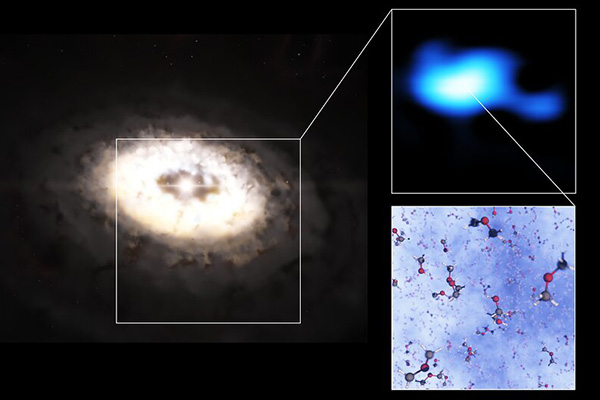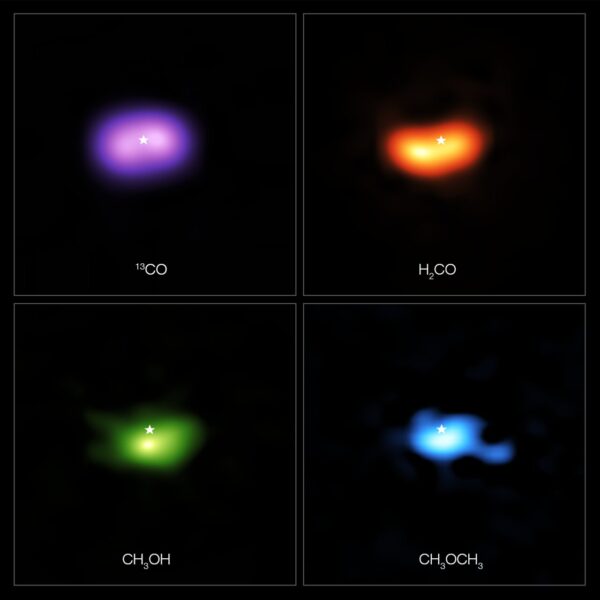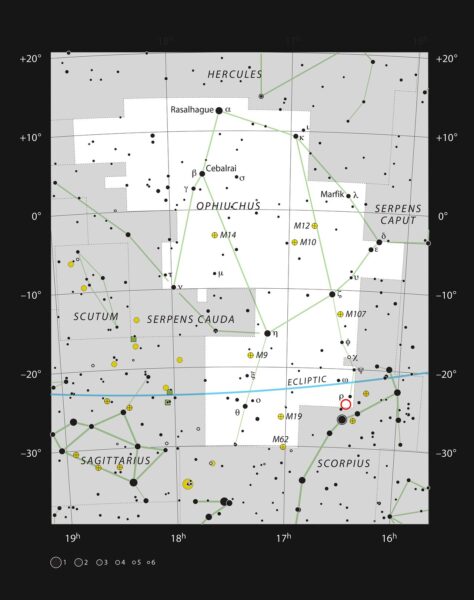The detection of a complex organic molecule in the disk around an infant star suggests prebiotic chemistry starts in the space between stars.

ESO / L. Calçada / ALMA (ESO / NAOJ / NRAO)/ A. Pohl / van der Marel et al. / Brunken et al.
Astronomers first detected molecules around and between stars in the 1930s. Now the tally of interstellar molecules — the chemical seeds of life — is well over 200, and recent finds are of increasing complexity. But it remains unclear if and how complex molecules migrate from the space between stars into planet-forming disks and ultimately onto planets themselves.
The tricky part is that astronomers detect these molecules in gas form, as they absorb light. That makes detections difficult in planet-forming disks, where most molecules exist as ices glommed onto dust grains. But a new study, published in Astronomy & Astrophysics, has done just that.
Nashanty Brunken (Leiden Observatory, The Netherlands) and colleagues report the first detection of dimethyl ether (CH3OCH3) in a protoplanetary disk, one of the most complex molecules found in a planet-forming environment to date. They also report a tentative detection of methyl formate (CH3OCHO).

ALMA (ESO / NAOJ /NRAO) / A. Pohl, van der Marel et al. / Brunken et al.
“It is really exciting to finally detect these larger molecules in disks,” says team member Alice Booth (also at Leiden Observatory). “For a while we thought it might not be possible to observe them.”
The detection was possible because the astronomers targeted Oph IRS 48, a star 440 light-years away in the constellation Ophiuchus. This star’s protoplanetary disk is famous in astronomical circles for its dust trap: Previous observations showed that while gas occupies the whole disk, the dust concentrates in a distinct crescent shape. Such dust traps are thought to host the initial stages of planet formation, as they promote the tangling of dust grains.
The researchers think that, as starlight shines on the inner edge of this dust trap, it “liberates” the molecules into a gaseous phase. Brunken’s team could then detect the molecules using the Atacama Large Millimeter/submillimeter Array (ALMA) in Chile. That molecules like dimethyl ether exist within the disk suggests that other complex organic molecules might reside there, too.
From Organic Molecules to Life
Dimethyl ether, used on Earth as a refrigerant and potential fuel source, doesn’t sound terribly organic, does it? Likewise, methyl formate is occasionally employed as an insecticide, among other uses. Nevertheless, in the wilds of space these carbon- and hydrogen-containing molecules are precursors to prebiotic molecules, the far more complex sugars, amino acids, and other molecules that form the building blocks of life.
Astronomers had detected dimethyl ether in interstellar space before. But the fact that the team found it in Oph IRS 48’s disk — and with the same abundance as in interstellar space — supports the idea that complex organic molecules created in vast, cold clouds of dust and gas are ultimately pulled into forming planetary systems.
Karin Öberg (Harvard), who was not involved in the study, says, “I think the scenario they present is the most plausible one.”

ESO / IAU and Sky & Telescope
With additional observations, astronomers will eventually be able to follow molecules’ full journey, from their formation into planet-forming disks and planetary bodies, shedding the light on the chemistry that led to life in the solar system.
 1
1









Comments
Rod
March 12, 2022 at 8:11 am
I followed a number of reports on Oph IRS 48 disk and molecule report. Here are some items I learned when digging deeper, including using the NASA ADS Abstract. IRS 48 has been studied in other reports too. The disk is small,0.6 Mjup, is very small compared to the MMSN of some 3300 earth masses for our solar system (total dust and gas), about 191 earth masses. How such molecules survive the accretion process and large-scale bombardments and impacts said to take place during accretion of planets in a spinning disk and evolve into life looks difficult 🙂 Oph IRS 48 is said to be an A0 star in Ophiuchus *star forming cloud*. An A0 star could be at least 2 solar masses so the MMSN applied here, results in a disk mass 6.658855E+03 or 6659 earth masses as a minimum. 191 earth mass disk is very small. The NASA ADS reports show the star mass is 2 Msun and the disk mass of 0.6 Mjup.
You must be logged in to post a comment.
You must be logged in to post a comment.